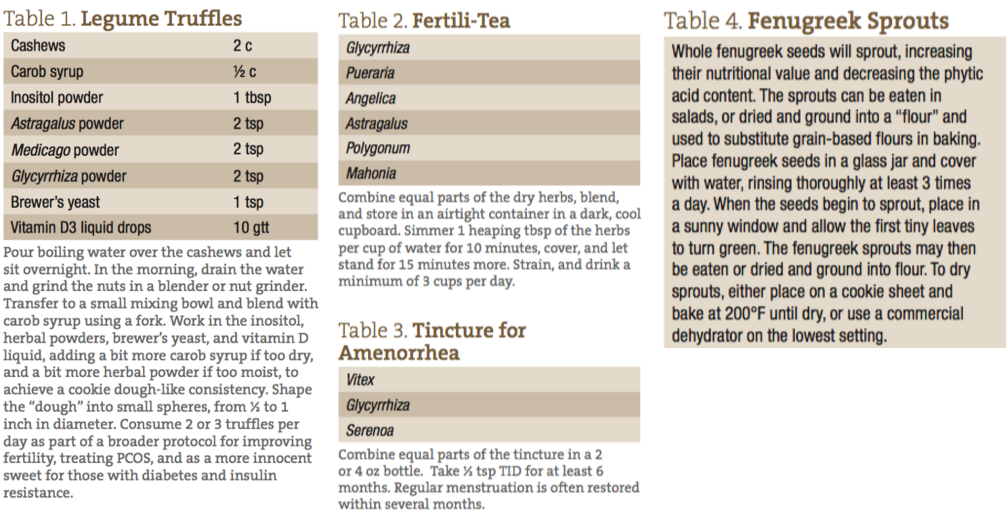Inositol Compounds: Effects on Fertility, Ovarian Function, & Insulin
Jillian Stansbury, ND
Polycystic ovary syndrome (PCOS) is the most common cause of infertility, affecting from 5-10% of all women. PCOS is commonly associated with insulin resistance, even in those with a normal body mass index (BMI). Insulin-sensitizing compounds not only improve insulin resistance and reduce the likelihood of developing diabetes, they may also improve ovarian response to endogenous gonadotropins, and reduce hyperandrogenemia, the hallmark of PCOS. Therefore insulin-sensitizing compounds may establish normal menstrual cycles and ovulation, and improve fertility.1
Endogenous Inositols
Many inositol compounds are found naturally in the human body, often in the form of phosphoinositides, and play roles in a great variety of molecular signaling pathways involved with cell proliferation and apoptosis, metabolism, movement of vesicles in the cell, fertility, and numerous other cellular functions.2 In the human body, specific kinase and phosphatase enzymes direct the generation of phosphoinositides from the inositol. Genetic mutation in various phosphoinositide phosphatase enzymes are now known to cause a wide range of human diseases, such as ciliopathies, degenerative neuropathy, diabetes, and leukemia.2
Inositol compounds, such as myo-inositol, pinitol, and D-chiro-inositol, are demonstrated to improve insulin response, as will improve ovarian function, metabolic and hormonal parameters, and support fertility.3 Mammalian ova bear inositol receptors that enhance egg maturation,4 and naturally occurring endogenous inositol compounds are essential to fertility. When endogenous inositol compounds are lacking or imbalanced, exogenous inositols, such as those occurring in legumes, may enhance fertility.5 Higher levels of naturally occurring myo-inositol in human ova and follicular fluid are associated with higher-quality oocytes, and supplementation appears to reduce hyperinsulinism and help restore fertility in women with PCOS.6
Clinical Trials on Inositol to Improve Female Fertility
One study examined the effects of myo-inositol in women who had previously responded poorly to in-vitro fertilization cycles.7 A total of 38 such women were treated with myo-inositol and folic acid, while another group of 38 women was given folic acid alone. The women given the myo-inositol showed greater maturation of ova, due to enhanced response to gonadotropins (but without estradiol being affected).
Insulin resistance contributes to the pathogenesis of PCOS, and to the infertility and chronic miscarriage associated with this condition. One study8 investigated the efficacy of myo-inositol to induce ovulation in 50 women with anovulatory cycles associated with PCOS and proven insulin resistance, followed by myo-inositol in combination with clomiphene for those who failed to respond to myo-inositol alone. Myo-inositol induced ovulation in 62% of women within 3 menstrual cycles (with 38% of them achieving pregnancy), while 38% of women were noted to be “resistant” to myo-inositol.8 For those who were resistant, clomiphene was administered with the myo-inositol; 72% of these women then ovulated, with 42% achieving pregnancy. The study also noted myo-inositol to improve BMI.8
A similar study9 showed that D-chiro-inositol, given to women with PCOS and insulin resistance for 12 weeks, improved BMI and insulin response, as well as improved the luteinizing hormone response to gonadotropin-releasing hormone.
Another study compared metformin to myo-inositol with folic acid, in terms of their ability to induce ovulation in infertile women with PCOS.10 Fifty percent of the women given metformin showed improved ovulation (with 18% achieving pregnancy), while 65% of those given myo-inositol (4 grams per day) showed improved ovulation (with 30% achieving pregnancy).10
Legumes: A Natural Source of Inositols
Plants containing large amounts of inositols are largely legumes, including soybean (Glycine max), red and white clover (Trifolium pratense), kudzu (Pueraria mirifica),11 carob (Ceratonia spp),12 and commonly used herbal medicines, such as milk vetch (Astragalus),13 licorice (Glycyrrhiza glabra),14 and alfalfa (Medicago sativa).15 Legumes contain the inositol compound, pinitol (3-O-methyl-chiro-inositol), at approximately 200-600 mg/100 g fresh weight.11 Chickweed (Stellaria) and Ginkgo biloba also contain pinitol, while green coffee extracts (Coffea) contain myo-inositol,16 and dandelion (Taraxicum officinale) contains chiro-inositol.11 Carob may contain almost 95 g/kg of pinitol,17 is readily available in South American and Mediterranean markets, and has been shown to improve insulin sensitivity and glycemic control with chronic consumption.18
The pinitol in legumes can be converted into D-chiro-inositol in the body. One study19 supplemented diabetic patients with pinitol at a daily dose of 20 mg/kg body weight for 1 month, and found that their blood levels of D-chiro-inositol increased substantially by the end of the study.
Research on Individual Legume Herbs
Pueraria Species (Kudzu)
Pueraria tuberosa supports the reception of insulin at cell membrane receptors and enhances signal transduction20; consequently, Pueraria species may reduce insulin resistance.21 Pueraria makes a tasty tea, and powders are also available to use in smoothies and medicinal foods.
Astragalus Membranaceus (Milk Vetch)
Astragalus roots have many medicinal benefits, including helping to protect tissues from inflammation caused by high blood sugar.22,23 Astragalus contains inositol compounds that may improve insulin response in cells,24 and enhance muscle and hepatic cell uptake of glucose,25 due to increasing signal transduction at insulin receptors.26 One small human clinical trial showed Astragalus to improve insulin resistance in diabetic subjects.27 The herb may be used as tinctures, pills, and medicinal foods, as its bland, starchy flavor lends itself to soups, smoothies, and handmade truffles (See Table 1).
Medicago Sativa (Alfalfa, Lucern)
Medicago is a highly nutritious herb and is a fairly rare plant that contains vitamins D and K. Medicago also contains saponins28 that are credited with many medicinal effects, as well as D-chiro-inositol and related compounds. Medicago is an age-old medicine for diabetics in the form of teas, and the fresh plant can also be juiced in a wheatgrass juicer when available. Animal research has suggested that the plant can enhance glucose metabolism.29 Even alfalfa sprouts contain phytoestrogens that may help regulate hormones, and are reported to prevent heart disease, cancer, and menopausal symptoms.30,31
Glycyrrhiza (Licorice)
Licorice tea can be a simple and inexpensive prong of a broader protocol for treating PCOS, improving insulin resistance and restoring regular menstrual cycles. Licorice is a traditional remedy in Japan for amenorrhea, combining well with Vitex for this purpose. In addition to the inositol compounds, the saponin glycyrrhizic acid may also improve insulin resistance and fat metabolism, as demonstrated in animal models of metabolic syndrome.32 Glycyrrhiza has been found to reduce inflammation and support function in animal models of diabetic kidney damage,33 improve insulin sensitivity and reduce fat deposition in tissues,32 and suppress the accumulation of abdominal fat.34
One clinical study administered Glycyrrhiza to women with PCOS who were using the androgen-blocking drug, spironolactone.35 Glycyrrhiza was shown to reduce the tendency of spironolactone to impair mineralocorticoid receptors and mineral status in the body. Of note, no women were reported to experience a rise in blood pressure from licorice – a commonly reported but actually rare side effect of regular consumption of Glycyrrhiza. This herb may also represent a good alternative to spironolactone, due to its ability to reduce elevated testosterone.
Trigonella Foenum-graecum (Fenugreek)
Fenugreek is another legume that is used traditionally for diabetes. The aromatic seeds are shown to reduce blood glucose in both type I and type II diabetes. Fenugreek supplementation improves hyperglycemia almost as effectively as insulin itself in type I diabetic animals,36 and with equal effectiveness as metformin in type II diabetic animals.37 Trigonella improves glucose tolerance and reduces elevated blood fats.38 One human clinical study showed fenugreek to improve fasting blood sugar levels, post-prandial glycemic control, and glycosylated hemoglobin.39
Phytic Acid is an Inositol Compound
One inositol phosphate, inositol hexakisphosphate, is also known as IP6 or phytic acid.40 It is the major storage form of phosphorus in legumes, nuts, and cereal grains, and is referred to as an “anti-nutrient.” This is because it can bind minerals and deter their absorption; eating improperly prepared beans or a large amount of whole grains can lead to iron, zinc, and other mineral deficiencies.41
Soaking beans with an acid such as vinegar, especially hot-soaking at 90 degrees or more, can reduce phytates by as much as 50%.42 Sprouting43 and fermenting grains and beans will also significantly reduce the phytic acid. Even nut butters are healthier when the nuts are soaked prior to grinding. The anti-nutrient effects of phytic acid are exacerbated by high amounts of calcium, and mitigated by Vitamin D.44 Plants also provide phytase, which breaks down phytic acid and minimizes its anti-nutrient effects. Healthy intestinal flora can liberate phytase and minimize the anti-nutrient effects of diets high in beans, nuts, and whole grains.

 Jillian Stansbury, ND, has practiced in SW Washington for nearly 20 years, specializing in women’s health, mental health, and chronic disease. She holds undergraduate degrees in medical illustration and medical assisting, and graduated with honors in both programs. Dr Stansbury also chaired the botanical medicine program at NCNM and has taught the core botanical curricula for more than 20 years. In addition, Dr Stansbury writes and serves as a medical editor for numerous professional journals and lay publicans, plus teaches natural products chemistry and herbal medicine around the country. At present, she is working to set up a humanitarian service organization in Peru and studying South American ethnobotany. She is the mother of 2 adult children, and her hobbies include art, music, gardening, camping, international travel, and the study of quantum and metaphysics.
Jillian Stansbury, ND, has practiced in SW Washington for nearly 20 years, specializing in women’s health, mental health, and chronic disease. She holds undergraduate degrees in medical illustration and medical assisting, and graduated with honors in both programs. Dr Stansbury also chaired the botanical medicine program at NCNM and has taught the core botanical curricula for more than 20 years. In addition, Dr Stansbury writes and serves as a medical editor for numerous professional journals and lay publicans, plus teaches natural products chemistry and herbal medicine around the country. At present, she is working to set up a humanitarian service organization in Peru and studying South American ethnobotany. She is the mother of 2 adult children, and her hobbies include art, music, gardening, camping, international travel, and the study of quantum and metaphysics.
References
- Cittadini E. The role of inositol supplementation in patients with polycystic ovary syndrome, with insulin resistance, undergoing the low-dose gonadotropin ovulation induction regimen. Fertil Steril. 2011;95(8):e57.
- Hakim S, Bertucci MC, Conduit SE, et al. Inositol polyphosphate phosphatases in human disease. Curr Top Microbiol Immunol. 2012;362:247-314.
- Unfer V, Carlomagno G, Dante G, Facchinetti F. Effects of myo-inositol in women with PCOS: a systematic review of randomized controlled trials. Gynecol Endocrinol. 2012;28(7):509-515.
- Zhang N, Yoon SY, Parys JB, Fissore RA. Effect of M-phase kinase phosphorylations on type 1 inositol 1,4,5-trisphosphate receptor-mediated Ca(2+) responses in mouse eggs. Cell Calcium. 2015;58(5):476-488.
- Caprio F, D’Eufemia MD, Trotta C, et al. Myo-inositol therapy for poor-responders during IVF: a prospective controlled observational trial. J Ovarian Res. 2015;8(1):37.
- Papaleo E, Unfer V, Baillargeon JP, Chiu TT. Contribution of myo-inositol to reproduction. Eur J Obstet Gynecol Reprod Biol. 2009;147(2):120-123.
- Ciotta L, Stracquadanio M, Pagano I, et al. Effects of myo-inositol supplementation on oocyte’s quality in PCOS patients: a double blind trial. Eur Rev Med Pharmacol Sci. 2011;15(5):509-514.
- Kamenov Z, Kolarov G, Gateva A, et al. Ovulation induction with myo-inositol alone and in combination with clomiphene citrate in polycystic ovarian syndrome patients with insulin resistance. Gynecol Endocrinol. 2015;31(2):131-135.
- Genazzani AD, Santagni S, Rattighieri E, et al. Modulatory role of D-chiro-inositol (DCI) on LH and insulin secretion in obese PCOS patients. Gynecol Endocrinol. 2014;30(6):438-443.
- Raffone E, Rizzo P, Benedetto V. Insulin sensitiser agents alone and in co-treatment with r-FSH for ovulation induction in PCOS women. Gynecol Endocrinol. 2010;26(4):275-280.
- Negishi O, Mun’im A, Negishi Y. Content of methylated inositols in familiar edible plants. J Agric Food Chem. 2015;63(10):2683-2688.
- Tetik N, Yüksel E. Ultrasound-assisted extraction of D-pinitol from carob pods using Response Surface Methodology. Ultrason Sonochem. 2014;21(2):860-865.
- Tarazona JV, Sanz F. Toxicity of fractions obtained from the legume species Astragalus lusitanicus Lam. lusitanicus. 1990;28(2):235-237.
- Biondi DM, Rocco C, Ruberto G. Dihydrostilbene derivatives from Glycyrrhiza glabra leaves. J Nat Prod. 2005;68(7):1099-1102.
- Zhang JY, Cruz DE Carvalho MH, et al. Global reprogramming of transcription and metabolism in Medicago truncatula during progressive drought and after rewatering. Plant Cell Environ. 2014;37(11):2553-2576.
- Ruiz-Matute AI, Montilla A, del Castillo MD, et al. A GC method for simultaneous analysis of bornesitol, other polyalcohols and sugars in coffee and its substitutes. J Sep Sci. 2007;30(4):557-562.
- Tetik N, Turhan I, Oziyci HR, Karhan M. Determination of D-pinitol in carob syrup. Int J Food Sci Nutr. 2011;62(6):572-576.
- Bañuls C, Rovira-Llopis S, Falcón R, et al. Chronic consumption of an inositol-enriched carob extract improves postprandial glycaemia and insulin sensitivity in healthy subjects: A randomized controlled trial. Clin Nutr. 2015 May 23. pii: S0261-5614(15)00137-5.
- Davis A, Christiansen M, Horowitz JF, et al. Effect of pinitol treatment on insulin action in subjects with insulin resistance. Diabetes Care. 2000;23(7):1000-1005.
- Dey D, Pal BC, Biswas T, et al. A Lupinoside prevented fatty acid induced inhibition of insulin sensitivity in 3T3 L1 adipocytes. Mol Cell Biochem. 2007;300(1-2):149-157.
- Bai HY, Zou WJ, Gao XP. Influence of Pueraria thomsonii on insulin resistance induced by dexamethasone. [Article in Chinese] Zhongguo Zhong Yao Za Zhi. 2004;29(4):356-358.
- Zhang N, Wang XH, Mao SL, Zhao F. Astragaloside IV improves metabolic syndrome and endothelium dysfunction in fructose-fed rats. Molecules. 2011;16(5):3896-3907.
- Yin X, Zhang Y, Yu J, et al. The antioxidative effects of astragalus saponin I protect against development of early diabetic nephropathy. J Pharmacol Sci. 2006;101(2):166-173.
- Xu ME, Xiao SZ, Sun YH, et al. Effects of astragaloside IV on pathogenesis of metabolic syndrome in vitro. Acta Pharmacol Sin. 2006;27(2):229-236.
- Zou F, Mao XQ, Wang N, et al. Astragalus polysaccharides alleviates glucose toxicity and restores glucose homeostasis in diabetic states via activation of AMPK. Acta Pharmacol Sin. 2009;30(12):1607-1615.
- Liu M, Wu K, Mao X, et al. Astragalus polysaccharide improves insulin sensitivity in KKAy mice: regulation of PKB/GLUT4 signaling in skeletal muscle. J Ethnopharmacol. 2010;127(1):32-37.
- Chao M, Zou D, Zhang Y, et al. Improving insulin resistance with traditional Chinese medicine in type 2 diabetic patients. 2009;36(2):268-274.
- Kapusta I, Stochmal A, Perrone A, et al. Triterpene saponins from barrel medic (Medicago truncatula) aerial parts. J Agric Food Chem. 2005;53(6):2164-2170.
- Gray AM, Flatt PR. Pancreatic and extra-pancreatic effects of the traditional anti-diabetic plant, Medicago sativa (lucerne). Br J Nutr. 1997;78(2):325-334.
- Kurzer MS, Xu X. Dietary phytoestrogens. Annu Rev Nutr. 1997;17:353-381.
- Branca F, Lorenzetti S. Health effects of phytoestrogens. Forum Nutr. 2005;(57):100-111.
- Eu CH, Lim WY, Ton SH, bin Abdul Kadir K. Glycyrrhizic acid improved lipoprotein lipase expression, insulin sensitivity, serum lipid and lipid deposition in high-fat diet-induced obese rats. Lipids Health Dis. 2010;9:81.
- Kataya HH, Hamza AA, Ramadan GA, Khasawneh MA.. Effect of licorice extract on the complications of diabetes nephropathy in rats. Drug Chem Toxicol. 2011;34(2):101-108.
- Nakagawa K, Kishida H, Arai N, et al. Licorice flavonoids suppress abdominal fat accumulation and increase in blood glucose level in obese diabetic KK-A(y) mice. Biol Pharm Bull. 2004;27(11):1775-1778.
- Armanini D, Castello R, Scaroni C, Bonanni G, Faccini G, Pellati D, Bertoldo A, Fiore C, Moghetti P. Treatment of polycystic ovary syndrome with spironolactone plus licorice. Eur J Obstet Gynecol Reprod Biol. 2007;131(1):61-67.
- Baquer NZ, Kumar P, Taha A, et al. Metabolic and molecular action of Trigonella foenum-graecum (fenugreek) and trace metals in experimental diabetic tissues. J Biosci. 2011;36(2):383-396.
- Kannappan S, Anuradha CV. Insulin sensitizing actions of fenugreek seed polyphenols, quercetin & metformin in a rat model. Indian J Med Res. 2009;129(4):401-408.
- Moorthy R, Prabhu KM, Murthy PS. Anti-hyperglycemic compound (GII) from fenugreek (Trigonella foenum-graecum Linn.) seeds, its purification and effect in diabetes mellitus. Indian J Exp Biol. 2010;48(11):1111-1118.
- Lu FR, Shen L, Qin Y, et al. Clinical observation on trigonella foenum-graecum L. total saponins in combination with sulfonylureas in the treatment of type 2 diabetes mellitus. Chin J Integr Med. 2008;14(1):56-60.
- Kolozsvari B, Parisi F, Saiardi A. Inositol phosphates induce DAPI fluorescence shift. Biochem J. 2014;460(3):377-385.
- Metzler-Zebeli BU, Deckardt K, Schollenberger M, et al. Lactic acid and thermal treatments trigger the hydrolysis of myo-inositol hexakisphosphate and modify the abundance of lower myo-inositol phosphates in barley (Hordeum vulgare L.). PLoS One. 2014;9(6):e101166.
- Gupta RK, Gangoliya SS, Singh NK. Reduction of phytic acid and enhancement of bioavailable micronutrients in food grains. J Food Sci Technol. 2015;52(2):676-684.
- Devi CB, Kushwaha A, Kumar A. Sprouting characteristics and associated changes in nutritional composition of cowpea (Vigna unguiculata). J Food Sci Technol. 2015;52(10):6821-6827.
- Pallauf J, Rimbach G. Nutritional significance of phytic acid and phytase. Arch Tierernahr. 1997;50(4):301-319.










